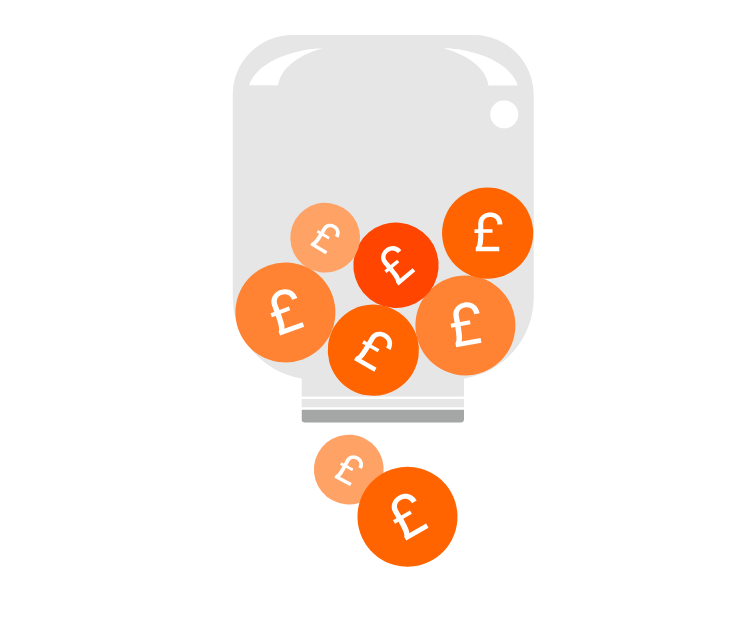ii SIPP
SIPP tax relief
Learn more about SIPP tax benefits and how pension tax relief works.

Important information: A SIPP is for those wanting to make their own investment decisions when saving for retirement. As investment values can go down as well as up, the amount you retire with could be worth less than you invested. Usually, you won’t be able to withdraw your money until age 55 (57 from 2028). Before transferring your pension, check if you’ll be charged any exit fees and make sure you don't lose any valuable benefits such as guaranteed annuity rates, lower protected pension age or matching employer contributions. If you’re unsure about opening a SIPP or transferring your pension(s), please speak to an authorised financial adviser.
How does SIPP tax relief work?
SIPP tax relief is essentially a government contribution to your pension. It is designed to encourage saving for the future.
The government pays at least 20% of the total amount you invest in your SIPP.
For example, if you pay £80 into your SIPP, it will be topped up with 20% tax relief. This turns your contribution into £100 in your pension.
Essentially, every 80p you pay in is topped up to £1.

How much tax relief will I get?
The amount of SIPP tax relief you can receive depends on your income tax band.
Your provider will always claim 20% tax relief for you as standard.
It usually takes 6-11 weeks to receive the tax reclaim from HMRC.
Tax relief for higher and additional-rate taxpayers
Higher-rate and additional-rate taxpayers receive the same 20% tax relief as basic rate taxpayers but they are able to claim back an extra 20% or 25% through their self-assessment tax returns.
Tax relief rates
Tax relief effectively means that the government returns some of the income tax you have paid as a pension contribution.
Tax relief rates are:
- 20% for basic-rate taxpayers
- 40% for higher-rate taxpayers (anyone earning over £50,270 annually)
- 45% for additional-rate taxpayers (anyone earning over £125,140)
Income tax in Scotland is banded differently, as follows:
- 20% for basic-rate taxpayers
- 21% for intermediate-rate taxpayers
- 42% for higher-rate taxpayers
- 47% for additional-rate taxpayers
If you are a Scottish taxpayer, your provider will still claim the first 20% automatically, but you will need to claim the remaining 1%, 22% or 27% if you are an intermediate-rate, higher-rate or additional-rate taxpayer.

Tax relief for non-taxpayers
If you are a non-taxpayer – for instance, you’re unemployed – you can still qualify for tax relief on annual contributions up to £3,600.
This is equivalent to a personal contribution of £2,880 and tax relief of £720 (20%).
How tax relief boosts your SIPP
This table shows the total cost of contributing £1,250 to a SIPP at different rates of tax relief:
Non-taxpayer | Basic rate taxpayer (20%) | Higher-rate taxpayer (40%) | Additional-rate taxpayer (45%) | |
Total contribution | £1,250 | £1,250 | £1,250 | £1,250 |
You pay | £1,000 | £1,000 | £1,000 | £1,000 |
Government contribution (20%) | £250 | £250 | £250 | £250 |
Amount you can claim on your tax return | £0 | £0 | £250
| £312.50
|
How much a £1,250 SIPP contribution costs you | £1,000 | £1,000 | £750 | £687.50 |
SIPP annual allowance
You can contribute up to the lower of £60,000 or 100% of your earnings into your pensions each tax year.
Thanks to the tax relief, if you're a basic rate tax payer this means you only need to contribute up to £48,000 of your own money and it will be topped up with £12,000 in tax relief to make a contribution of £60,000.
You may be able to increase the amount you can invest if you have not used your full allowance in any of the previous three years. This is known as the carry forward rule.
The carry forward rule allows you to take advantage of any unused annual allowance from the previous three tax years.
To be eligible, you must have:
- Been a member of a pension scheme in each tax year from which you carry forward.
- Used up your full annual allowance in the current tax year.
- Contributed less than £40,000 in one or more of the last three tax years (including personal and employer contributions).
- Earned at least the amount you are contributing - including any contributions you want to carry forward - in that tax year, if you are making personal contributions.
If you are eligible you use up any unused annual allowance from the earliest year first.

Higher earners and the SIPP annual allowance
If you have an income of £200,000 or more, you may be subject to a tapered annual allowance. This reduces the amount you can pay into your SIPP that tax year and receive tax relief.
Two figures are important when determining whether you are affected – your threshold income and your adjusted income.
The calculations are complex but your threshold income is broadly your net income, which includes salary, bonuses, dividend income, income from property and so on. Your adjusted income is your net income plus the value of any employer pension contributions.
Your annual allowance reduces by £1 for every £2 that your adjusted income exceeds £260,000.
If it reaches £360,000, you will be subject to the maximum £50,000 reduction in annual allowance. This means your annual allowance would be reduced to £10,000.
If your threshold income is below £200,000, the annual allowance taper will not be triggered.
Tax relief after you take your pension
Once you start taking money from your pension – either as income drawdown, UFPLS or a flexible or investment-linked annuity – you trigger the Money Purchase Annual Allowance (MPAA).
The MPAA reduces the maximum amount you can contribute to your pension and receive tax relief to the lower of £10,000 and your annual income. Because of tax relief, this means you could contribute £8000 of your own money, if you are a basic rate tax payer earning at least £10,000, and receive up to £2,000 in tax relief.
The MPAA will not be triggered if you have only taken your tax-free lump sum from your SIPP or you have taken out a lifetime annuity.
